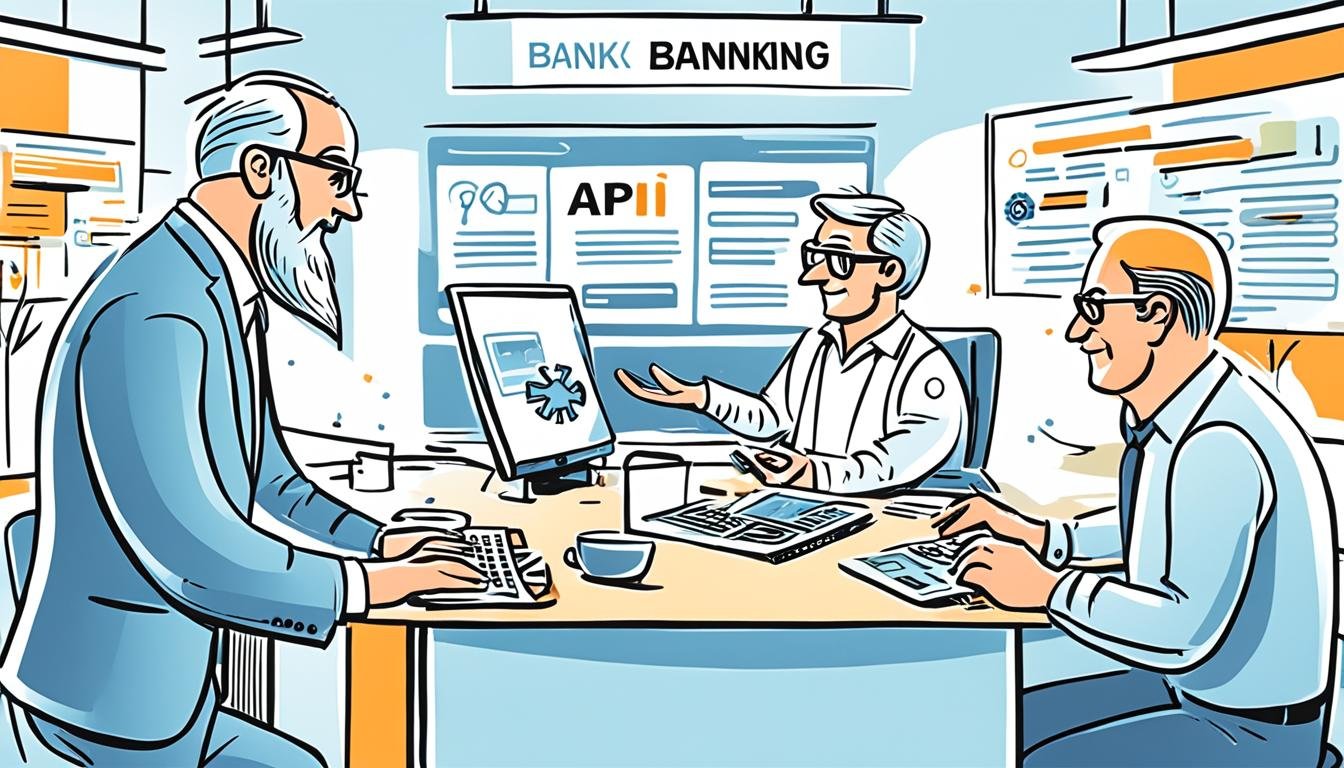The Adoption of API Banking and Its Implications
Did you know that the rapid adoption of fintech and financial APIs has led to a staggering 52% increase in US fintech users in just one year? This statistic highlights the immense value that API banking brings to consumers and the significant impact it has on the finance industry.
API banking, also known as open banking, allows for secure data connections between consumers’ financial accounts and fintech apps. This integration not only provides better choices for consumers but also revolutionizes the way financial services are delivered. From saving time and money to reducing fear and stress, API banking has become a top priority for consumers when choosing a bank.
In this article, we will explore the benefits, trends, and impact of API banking in the finance industry. We will delve into how API banking is reshaping the way we manage our finances, the changing regulatory landscape surrounding its adoption, and the future of this technological advancement. Join us as we dive into the world of API banking and discover its implications for businesses and consumers alike.
Key Takeaways:
- API banking has experienced a 52% increase in US fintech users in just one year.
- The adoption of API banking provides better choices for consumers, saving them time, money, and reducing fear and stress.
- Linking financial accounts to fintech apps is a top priority for consumers when choosing a bank.
- Changing regulations and technical standards support the growth of API banking.
- The future of API banking is promising, with open banking regulations expanding globally and increased competition and innovation.
Better Choices for Consumers
Fintech solutions have revolutionized the financial landscape, providing consumers with better choices and transforming their banking experience. These innovative technologies offer a range of benefits, including saving time, saving money, and reducing fear and stress.
One notable fintech solution that has gained popularity is Chime, a leading neobank that offers a variety of features tailored to meet consumer needs. With Chime, account holders can enjoy fee-free checking accounts, no-fee overdraft protection, and no minimum balances. Additionally, Chime provides access to fee-free ATMs and the opportunity to build a credit history without incurring interest fees. These features empower consumers by eliminating unnecessary fees, promoting financial health, and providing convenient access to their funds.
The growing adoption of fintech solutions reflects the increasing consumer demand for digital banking services. The average US millennial uses 4.3 fintech apps, while the average Baby Boomer uses 2.6, highlighting the widespread appeal of these technologies across different age groups. When choosing a bank, consumers prioritize the ability to link their accounts to fintech apps, allowing for seamless integration and enhanced financial management.
Chime’s success and the expansion of the overall fintech ecosystem demonstrate the value consumers place on improved financial services and solutions. By offering a comprehensive suite of features and prioritizing customer needs, fintech companies like Chime have redefined traditional banking and empowered consumers to take control of their finances.
“Fintech solutions provide consumers with enhanced financial choices, saving time and reducing stress.”
Changing Regulatory Landscape
Changing regulations play a significant role in shaping the field of API banking. One crucial regulation affecting the fintech ecosystem is Section 1033 of the Dodd-Frank Wall Street Reform and Consumer Protection Act. With the aim of enhancing transparency, visibility, competition, and innovation, this provision requires financial institutions to grant consumers access to their financial information.
This regulatory environment promotes the growth of open banking, where APIs facilitate data access and empower consumers to use their financial information according to their needs.
“Section 1033 of the Dodd-Frank Act advances consumer access to financial data. It encourages continued innovation by allowing consumers to share their financial information with third-party apps that can enhance financial management and decision-making.”
The involvement of the Consumer Financial Protection Bureau (CFPB) further highlights the US government’s commitment to open banking and positive regulations. The bureau’s Advanced Notice of Proposed Rulemaking (ANPR) signifies a robust regulatory framework that drives the development of API-driven open banking solutions.
This supportive regulatory landscape fosters the growth of the fintech ecosystem, enabling collaboration between financial institutions and fintech companies to deliver innovative and customer-centric solutions.
Key Regulations and Institutions:
| Regulation | Description |
|---|---|
| Section 1033 of Dodd-Frank Act | Requires financial institutions to provide consumer access to their financial information. |
| Consumer Financial Protection Bureau (CFPB) | Regulatory body focused on consumer protection and enforcing regulations such as Section 1033. |
| Advanced Notice of Proposed Rulemaking (ANPR) | CFPB’s process for gathering public feedback and insights to develop effective regulations for open banking solutions. |
These regulatory developments demonstrate the commitment to data access, transparency, and empowering consumers in the modern financial landscape.
Increasing Technical Standards
As the use of APIs becomes more prevalent in the financial industry, it is essential to establish robust technical standards to ensure the safe and reliable access of financial data. The Financial Data Exchange (FDX) is at the forefront of setting these standards, providing the necessary framework for secure connections within the financial data ecosystem.
APIs have emerged as the preferred method for connecting consumer financial data to fintech apps due to their high reliability and adherence to technical standards. By implementing FDX’s guidelines, financial institutions can ensure consistent data transmission, reducing the risk of errors and improving the overall user experience.
Collaboration between FDX and industry leaders like Plaid has resulted in the development of technical standards that prioritize control, access, transparency, traceability, and security. These standards provide a solid foundation for the integration of financial data through APIs, enabling secure and seamless connectivity within the fintech ecosystem.
The Role of Plaid Exchange
Plaid Exchange, in partnership with FDX, offers financial institutions a comprehensive solution for easy and secure access to the fintech ecosystem. By leveraging Plaid Exchange, banks can provide their customers with an enhanced user experience, while maintaining control and security over their financial data.
The collaboration between Plaid and FDX ensures that institutions adopting Plaid Exchange adhere to the highest technical standards, fostering trust and confidence among consumers and industry stakeholders.
With the growth of APIs and the implementation of these technical standards, the mass adoption of fintech solutions is propelled forward, driving innovation and transforming the financial industry as a whole.
The Role of API Banking in Digital Transformation
API banking, also known as open banking, plays a crucial role in driving digital transformation in the banking industry. By leveraging bank APIs, account holders can take control of their data and securely share it with third-party applications. This enables users to customize their banking experience according to their specific needs and preferences.
With API banking, account holders gain real-time insights into their cash position, allowing them to make informed financial decisions. They can access personalized budget plans, track their expenses, and optimize their savings. Additionally, API banking facilitates streamlined international payments, making cross-border transactions more efficient and cost-effective.
APIs act as a communication bridge between different applications, ensuring seamless data transmission and integration. This enhances the overall digital banking capabilities, providing users with a more convenient and user-friendly banking experience. With API banking, customers can access their financial information from various platforms and enjoy a consistent and unified experience across different banking services.
One of the key advantages of API banking is increased data transparency. Account holders have full visibility into their financial data, allowing them to monitor their transactions, identify patterns, and gain valuable insights into their financial health. This transparency empowers users to make better financial decisions and maintain a more accurate understanding of their overall financial well-being.
Furthermore, API banking enables a more personalized banking experience. Through the integration of various financial apps and services, account holders can access personalized recommendations tailored to their financial goals and preferences. This level of customization enhances the overall user experience and improves customer satisfaction.
API banking revolutionizes the way account holders interact with their banks and financial services. It enables a seamless and personalized experience, providing users with greater control over their financial data and empowering them to make informed financial decisions.
Benefits of API Banking in Digital Transformation:
- Enhanced control of account holders over their own financial data
- Real-time insights into cash position and personalized budget plans
- Streamlined international payments for improved convenience
- Seamless integration of multiple applications for a unified banking experience
- Increased data transparency for better financial decision-making
- Personalized recommendations for tailored financial services
API banking is a key driver of digital transformation in the banking industry. It empowers account holders with greater control, data transparency, and a personalized banking experience. As the industry continues to embrace digital innovation, API banking will play a pivotal role in shaping the future of banking.
The Advantages of API Banking for Businesses
API banking offers numerous advantages for businesses, empowering them with enhanced visibility into their cash flow, streamlined operations, and reduced fees. Let’s explore the key benefits that API banking brings to businesses:
1. Visibility into Cash Flow
API banking provides businesses with a comprehensive view of their cash flow in real-time. By connecting their financial accounts to a centralized payment dashboard, businesses can easily monitor incoming and outgoing transactions, helping them make more informed decisions about their finances.
2. Streamlined Operations
Through API banking, businesses can streamline their operations by automating various financial processes. Predefined APIs enable seamless integration between different systems, eliminating manual data entry and reducing the risk of errors. This automation saves time and resources, allowing businesses to focus on core activities.
3. Compliance
API banking helps businesses improve compliance with the evolving regulatory landscape. By leveraging predefined APIs, businesses can ensure that their financial operations adhere to industry standards and regulations. This reduces the risk of non-compliance and potential penalties, giving businesses peace of mind.
4. Reduced Fees
API banking enables businesses to reduce fees associated with traditional payment methods. Real-time payment capabilities and batch payment processing can significantly lower transaction costs, resulting in substantial savings for businesses. These reduced fees contribute to improved financial performance and profitability.
5. Real-Time Payments
With API banking, businesses can enjoy the benefits of real-time payment processing. This means faster fund transfers, quicker settlements, and improved cash flow management. Real-time payments provide businesses with greater flexibility and liquidity, helping them operate more efficiently.
6. Cash Burn Reduction
API banking offers businesses the tools and insights needed to reduce cash burn. Through real-time monitoring of financial data and analysis of cash flow patterns, businesses can identify areas of excessive spending and implement strategies to minimize unnecessary expenses. Cash burn reduction contributes to improved financial stability and sustainability.
7. Open Banking Revenue Potential
One of the significant advantages of API banking is the creation of revenue-sharing ecosystems. By participating in open banking partnerships and collaborations, businesses can unlock new revenue streams through subscriptions or referrals. The revenue potential of API-enabled services is projected to reach $2 billion by 2024, highlighting the substantial financial opportunities available.
API banking empowers businesses with increased efficiency, improved financial management, and new revenue opportunities. By leveraging the benefits of API banking, businesses can strengthen their operations, enhance their competitiveness, and drive growth in the evolving financial landscape.
The Benefits of API Banking for Consumers
API banking offers consumers a range of benefits that empower them to manage their personal finances effectively. By leveraging API technology, consumers gain access to various tools and features that enhance their banking experience and provide valuable insights into their financial well-being.
Enhanced Personal Finance Management through Budgeting Tools
API banking enables consumers to utilize powerful budgeting tools that help them track expenses, set financial goals, and make informed decisions about their spending habits. These tools provide real-time updates on income and expenses, categorize transactions, and offer personalized recommendations to improve financial management.
Customized Loan Offers and Credit Card Rewards
With API banking, consumers can take advantage of customized loan offers that cater to their specific financial needs. APIs enable lenders to access consumers’ recent financial history, allowing them to offer personalized loan terms and competitive interest rates.
Moreover, API banking facilitates credit card rewards programs that are tailored to consumers’ spending habits and preferences. By leveraging transaction data, credit card issuers can offer rewards and incentives that align with consumers’ purchasing patterns, enhancing their overall credit card experience.
Subscription Tracking for Better Financial Planning
API banking enables consumers to track their subscriptions effortlessly, providing them with a comprehensive overview of recurring expenses. By having visibility into their subscriptions, consumers can make more informed decisions about their financial commitments, potentially identifying opportunities to optimize their spending and save money.
Simplified Loan Applications and Enhanced Credit Opportunities
APIs simplify the loan application process by streamlining the collection and verification of financial data. Through secure data connections, consumers can grant lenders access to their financial history, minimizing the need for manual paperwork and making the loan application process faster and more convenient.
In addition to simplified loan applications, API banking offers consumers opportunities to improve their credit scores. By leveraging financial data insights, consumers can make informed decisions about their financial behaviors and take proactive steps towards improving their creditworthiness.
Biometric Authentication for Secure Banking Transactions
API banking incorporates advanced security measures, such as biometric authentication, to provide consumers with a secure banking experience. Biometric authentication, including fingerprint or facial recognition, adds an extra layer of protection, ensuring that only authorized individuals can access and carry out banking transactions.
| Benefits of API Banking for Consumers |
|---|
| Enhanced personal finance management through budgeting tools |
| Customized loan offers and credit card rewards |
| Subscription tracking for better financial planning |
| Simplified loan applications and enhanced credit opportunities |
| Biometric authentication for secure banking transactions |
The benefits of API banking for consumers are manifold, offering tools and features that empower individuals to take control of their finances, make informed decisions, and achieve their financial goals. With enhanced personal finance management tools, customized loan offers, credit card rewards, subscription tracking, simplified loan applications, and biometric authentication, consumers can enjoy a more tailored and convenient banking experience.
The Global Impact and Future of API Banking
Open banking is a global trend that is transforming the financial services industry worldwide. The adoption of open banking regulations, such as the EU’s Revised Payment Services Directive (PSD2), has been a catalyst for increased competition and the development of new technologies. In the US, API banking is gaining momentum, with companies like Robinhood and Chime already popular among consumers.
The revenue potential of open banking-enabled services is projected to reach $128.12 billion by 2030, highlighting the immense opportunities for innovation and growth in this sector. As open banking continues to gain traction, regulations are expanding globally, with countries like the UK, EU, and Australia leading the way in implementing open banking frameworks.
Driven by customer demand and competitive pressure, the adoption of open banking services is expected to increase further, offering a more transparent and customer-centric banking experience. This global shift towards open banking presents immense revenue potential and paves the way for further expansion of open banking regulations worldwide.
The Impact of EU’s Revised Payment Services Directive (PSD2)
The EU’s Revised Payment Services Directive (PSD2) has been instrumental in driving the adoption of open banking worldwide. By mandating that financial institutions provide secure access to customer data through APIs, PSD2 promotes competition and innovation within the financial services industry. This regulatory framework has paved the way for the development of new services and applications that enhance customer experiences and offer greater control over their financial data.
The Growing Adoption of API Banking in the US
In the US, API banking is witnessing significant adoption, with companies like Robinhood and Chime revolutionizing the way consumers manage their finances. These innovative fintech companies leverage APIs to connect to users’ financial data, providing seamless and personalized experiences. Consumers are increasingly drawn to these platforms for their user-friendly interfaces, enhanced financial management tools, and convenient access to banking services.
Expanding Open Banking Regulations Globally
Open banking regulations are expanding globally, driven by the need for increased financial transparency and improved customer experiences. Countries like the UK, EU, and Australia have been at the forefront of implementing open banking frameworks, requiring financial institutions to provide secure access to customer data through APIs. This global push towards open banking signifies the industry’s commitment to empowering customers and promoting innovative financial services.
Unlocking Revenue Potential through Open Banking
The revenue potential of open banking-enabled services is immense. According to industry projections, the open banking market is expected to reach $128.12 billion by 2030, driven by the increased adoption of open banking solutions and the development of new revenue models. The revenue potential stems from various sources, including subscription-based services, revenue sharing partnerships, and value-added products and services that leverage open banking APIs.
Overall, the future of API banking is bright, as it continues to revolutionize the finance industry on a global scale. Open banking regulations, like the EU’s PSD2, are driving increased competition, innovation, and consumer-centric solutions. As more countries embrace open banking and customers demand greater control over their financial data, the potential for growth and expansion in the API banking space is unprecedented.
Conclusion
API banking is revolutionizing the finance industry, offering numerous benefits for businesses and consumers alike. With the adoption of fintech and financial APIs, we are witnessing increased competition, innovation, and financial transparency in the sector.
For businesses, API banking opens up a world of possibilities. It provides visibility into cash flow, allowing organizations to make data-driven decisions. By streamlining operations and reducing fees through real-time payments, businesses can enhance efficiency and improve financial management. Furthermore, API banking enables the creation of new revenue streams, contributing to the growth and success of companies.
On the other hand, consumers are experiencing a transformation in the way they manage their finances. API banking offers personalized banking services, empowering individuals to take control of their financial well-being. With better financial management tools, consumers can budget effectively and achieve their financial goals. Moreover, API banking gives consumers increased oversight of their financial data, ensuring transparency and security.
The future of API banking looks promising with the widespread adoption of open banking regulations worldwide. As the industry continues to evolve, we can expect to see even greater competition, innovation, and financial transparency. API banking is reshaping the finance landscape, benefiting businesses and consumers, and paving the way for a more connected and efficient future.








